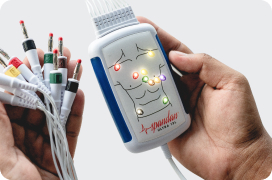
Related Article
Author:- Mr. Ritesh Sharma
Diastolic dysfunction heart failure is a condition that affects millions of people worldwide, yet remains relatively misunderstood by the general public. Unlike systolic heart failure, which involves the heart’s inability to pump blood effectively, diastolic dysfunction heart failure occurs when the heart’s ventricles become stiff and are unable to fill properly with blood during the diastolic phase. This blog aims to shed light on the causes, symptoms, diagnosis, and treatment options for this condition, offering valuable insights for those affected and their loved ones.
What is Diastolic Dysfunction Heart Failure?
Diastolic dysfunction heart failure, also known as heart failure with preserved ejection fraction (HFpEF), is characterized by the heart’s inability to relax and fill properly during the diastolic phase of the cardiac cycle. This results in inadequate blood flow to the rest of the body, leading to a range of symptoms and complications. Unlike systolic heart failure, where the heart’s pumping ability is impaired, diastolic dysfunction heart failure primarily involves issues with the heart’s filling capacity.
Causes of Diastolic Dysfunction Heart Failure
Several factors can contribute to the development of diastolic dysfunction heart failure, including:
- Aging: As people age, the heart’s tissues can become stiffer, reducing its ability to fill properly during diastole.
- Hypertension: Chronic high blood pressure can cause the heart muscles to thicken, leading to reduced elasticity and impaired filling.
- Diabetes: Diabetes can damage the heart muscles and blood vessels, contributing to diastolic dysfunction.
- Obesity: Excess body weight can strain the heart and contribute to structural changes that impair diastolic function.
- Coronary Artery Disease: Reduced blood flow to the heart muscles can cause damage and lead to diastolic dysfunction.
- Cardiomyopathy: Conditions that affect the heart muscles, such as hypertrophic cardiomyopathy, can impair the heart’s ability to relax and fill.
Symptoms of Diastolic Dysfunction Heart Failure
The symptoms of diastolic dysfunction heart failure can vary widely and often overlap with those of other types of heart failure. Common symptoms include:
- Shortness of Breath: Difficulty breathing, especially during physical activity or while lying down.
- Fatigue: Persistent tiredness and lack of energy.
- Swelling: Edema in the legs, ankles, and feet due to fluid retention.
- Chest Pain: Discomfort or pain in the chest, often exacerbated by physical exertion.
- Palpitations: Irregular or rapid heartbeats.
It’s important to note that these symptoms can be subtle and may worsen gradually over time. Early detection and management are crucial to prevent the progression of the disease and improve quality of life.
Diagnosing Diastolic Dysfunction Heart Failure
Diagnosing diastolic dysfunction heart failure requires a comprehensive evaluation by a healthcare professional. The diagnostic process typically includes:
- Medical History and Physical Examination: A thorough review of the patient’s medical history, symptoms, and physical examination findings.
- Echocardiogram: An ultrasound of the heart that assesses its structure and function, including diastolic filling patterns.
- Electrocardiogram (ECG): A test that records the electrical activity of the heart and helps identify any irregularities.
- Blood Tests: Laboratory tests to check for markers of heart failure and other underlying conditions.
- Cardiac MRI: Advanced imaging that provides detailed pictures of the heart’s structure and function.
Treatment Options for Diastolic Dysfunction Heart Failure
While there is no cure for diastolic dysfunction heart failure, several treatment options can help manage symptoms and improve quality of life. Treatment typically focuses on addressing underlying conditions, reducing symptoms, and preventing complications. Key approaches incl ude:
- Lifestyle Modifications: Adopting a heart-healthy lifestyle is crucial. This includes regular physical activity, a heart healthy diet low in sodium and saturated fats, maintaining a healthy weight, and avoiding smoking and excessive alcohol consumption.
- Medications: Several medications can help manage symptoms and underlying conditions:
- Diuretics: Help reduce fluid retention and alleviate swelling.
- ACE Inhibitors and ARBs: Lower blood pressure and reduce strain on the heart.
- Beta-Blockers: Help control heart rate and reduce blood pressure.
- Calcium Channel Blockers: Improve heart muscle relaxation and reduce blood pressure.
- Managing Comorbidities: Proper management of conditions like hypertension, diabetes, and obesity is essential for controlling diastolic dysfunction heart failure.
- Cardiac Rehabilitation: Structured exercise programs and education to help patients improve cardiovascular health and manage symptoms.
- Regular Monitoring: Ongoing follow-up with a healthcare provider to monitor the condition and adjust treatment as needed.
Living with Diastolic Dysfunction Heart Failure
Managing diastolic dysfunction heart failure requires a proactive and comprehensive approach. Patients should work closely with their healthcare providers to develop a personalized care plan that addresses their specific needs and goals. Key strategies include:
- Medication Adherence: Taking prescribed medications as directed and keeping track of any side effects.
- Symptom Monitoring: Keeping a diary of symptoms and reporting any changes to the healthcare provider.
- Healthy Lifestyle: Maintaining a heart-healthy lifestyle through diet, exercise, and stress management.
- Education and Support: Staying informed about the condition and seeking support from healthcare providers, family, and support groups.
Diastolic dysfunction heart failure is a complex and often challenging condition that requires careful management and ongoing care. By understanding the causes, symptoms, and treatment options, patients and their loved ones can take proactive steps to manage the condition and improve quality of life. With early detection, appropriate treatment, and a heart-healthy lifestyle, it is possible to live well with diastolic dysfunction heart failure.
Remember, if you or someone you know is experiencing symptoms of heart failure, it is essential to seek medical attention promptly. Early intervention can make a significant difference in managing the condition and preventing complications.
For more information on diastolic dysfunction heart failure and other heart-related conditions, consult with a healthcare provider or visit reputable health websites.




